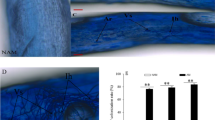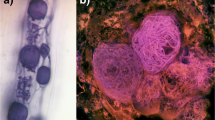Abstract
The aerenchyma differentiation in cable roots, pneumatophores, anchor roots, and feeding roots of the mangrove plant, Avicennia marina (Verbenaceae) was analyzed using a light microscope and scanning electron microscope. In all types, cortex cells were arranged in longitudinal columns extending from the endodermis to the epidermis. No cells in the cortex had intercellular spaces at the root tip (0–150 μm), and aerenchyma started developing at 200 μm from the root apex. The aerenchyma formation was due to cell separation (schizogeny) rather than cell lysis. The cell separation occurred between the longitudinal cell columns, forming long intercellular spaces along the root axis. During aerenchyma formation, the cortex cells enlarged longitudinally by 1.8–3.9 times and widened horizontally by 2.2–2.9 times. As a result, the aerenchyma had a pronounced tubular structure that was radially long, elliptical or oval in cross section and that ran parallel to the root axis. The tube had tapering ends, as did vessel elements, although there were no perforated plates. The interconnection between neighboring tubes was made by abundant small pores or canals that were schizogenous intercellular spaces between the wall cells. All aerenchyma tubes in the root were interconnected by these small pores serving as a gas pathway.







Similar content being viewed by others
References
Allaway WG, Curran M, Hollington LM, Ricketts MC, Skelton NJ (2001) Gas space and oxygen exchange in roots of Avicennia marina (Forssk.) Vierh. var. australasica (Walp.) Moldenke ex N.C. Duke, the grey mangrove. Wetland Ecol Manage 9:211–218
Armstrong W (1979) Aeration in higher plants. Adv Bot Res 7:275–332
Armstrong W, Brändle R, Jackson MB (1994) Mechanism of flood tolerance in plants. Act Bot Neerl 43:307–358
Baker RT (1915) The Australian ‘grey mangrove’. Proc R Soc NSW 78:509–514
Baylis GTS (1950) Root system of the New Zealand mangrove. Trans R Soc NZ 78:509–514
Chapman VJ (1939) Cambridge University expedition to Jamaica-part 3. The morphology of Avicennia nitida Jacq. and the function of its pneumatophores. J Linn Soc 52:487–533
Chapman VJ (1940) The functions of the pneumatophores of Avicennia nitida Jacq. Proc Linn Soc 153:228–233
Curran M (1985) Gas movement in the roots of Avicennia marina (Forsk.) Vierh. Aust J Pl Physiol 12:97–108
Curran M, Cole M, Allaway WG (1986) Root aeration and respiration in young mangrove plants [Avicennia marina (Forsk.) Vierh.]. J Exp Bot 37:1225–1233
Drew MC, He CJ, Morgan PW (2000) Programmed cell death and aerenchyma formation in roots. Trend Plant Sci 5:123–127
Fahn A (1990) Plant anatomy, 4th edn. Pergamon Press, New York, 588 pp
Fujii T (1993) Application of a resin casting method to wood anatomy of some Japanese Fagaceae species. IAWA J 14:273–288
Hogarth PJ (1999) The biology of mangroves. Oxford University Press, Oxford, 228 pp
Jackson MB, Armstrong W (1999) Formation of aerenchyma and the process of plant ventilation in relation to soil flooding and submergence. Plant Biol 1:274–287
Justin HFW, Armstrong W (1987) The anatomical characteristics of the roots and plant response to soil flooding. New Phytol 106:465–495
Lawton JR, Todd A, Naidoo DK (1981) Preliminary investigations into the structure of the roots of the mangroves Avicennia marina and Bruguiera gymnorhiza in relation to ion uptake. New Phytol 88:713–722
Longstreth DJ, Borkhsenious ON (2000) Root cell ultrastructure in developing aerenchyma tissue of three wetland species. Ann Bot 86:641–646
Mauseth JD, Fujii T (1994) Resin-casting: a method for investigating apoplastic spaces. Am J Bot 81:104–110
O’Brian T, McCully ME (1981) The study of plant structure: principles and selected methods. Termacarphi, Melbourne
Pezeshki SR (2001) Wetland plant responses to soil flooding. Environ Exp Bot 46:299–312
Purnobasuki H, Suzuki M (2004) Aerenchyma formation and porosity in root of a mangrove plant, Sonneratia alba J. Smith. J Plant Res 117:465–472
Sanderson JB (1994) Biological microtechnique. Bios Scientific, Oxford, 224 pp
Smirnoff N, Crawford RMM (1983) Variation in the structure and response to flooding of root aerenchyma in some wetland plants. Ann Bot 51:237–249
Vartapetian BB, Andreeva IN, Generozova IN, Polyakova LI, Maslova IP, Dolgikh YI, Stepanova AY (2003) Functional electron microscopy in studies of plant response and adaptation to anaerobic stress. Ann Bot 91:155–172
Webb J, Jackson MB (1986) A transmission and cryo-scanning electron microscopy study of the formation of aerenchyma (cortical gas-filled space) in adventitious roots of rice (Oryza sativa). J Exp Bot 37:832–841
Acknowledgements
We thank Prof. Tokushiro Takaso, Research Institute for Humanity and Nature, Kyoto, and the staff of Iriomote Station, Tropical Biosphere Research Center, University of Ryukyus, for their support in our field research. We also thank Kazutaka Kobayashi, Takahisa Tanaka, Youichi Hasegawa, Masanori Seki and Hiroaki Terasawa for their assistance in field sampling.
Author information
Authors and Affiliations
Corresponding author
Rights and permissions
About this article
Cite this article
Purnobasuki, H., Suzuki, M. Aerenchyma tissue development and gas-pathway structure in root of Avicennia marina (Forsk.) Vierh.. J Plant Res 118, 285–294 (2005). https://doi.org/10.1007/s10265-005-0221-7
Received:
Accepted:
Published:
Issue Date:
DOI: https://doi.org/10.1007/s10265-005-0221-7




